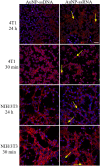Conjugation of microbial-derived gold nanoparticles to different types of nucleic acids: evaluation of transfection efficiency
- PMID: 37674013
- PMCID: PMC10482973
- DOI: 10.1038/s41598-023-41567-7
Conjugation of microbial-derived gold nanoparticles to different types of nucleic acids: evaluation of transfection efficiency
Abstract
In this study, gold nanoparticles produced by eukaryotic cell waste (AuNP), were analyzed as a transfection tool. AuNP were produced by Fusarium oxysporum and analyzed by spectrophotometry, transmission electron microscopy (TEM), scanning electron microscopy (SEM), and energy dispersive X-ray spectroscopy (EDS). Fourier transform infrared spectroscopy (FTIR) and dynamic light scattering (DLS) were used before and after conjugation with different nucleic acid (NA) types. Graphite furnace atomic absorption spectroscopy (GF-AAS) was used to determine the AuNP concentration. Conjugation was detected by electrophoresis. Confocal microscopy and quantitative real-time PCR (qPCR) were used to assess transfection. TEM, SEM, and EDS showed 25 nm AuNP with round shape. The amount of AuNP was 3.75 ± 0.2 µg/µL and FTIR proved conjugation of all NA types to AuNP. All the samples had a negative charge of - 36 to - 46 mV. Confocal microscopy confirmed internalization of the ssRNA-AuNP into eukaryotic cells and qPCR confirmed release and activity of carried RNA.
© 2023. Springer Nature Limited.
Conflict of interest statement
The authors declare no competing interests.
Figures







Similar articles
-
Accumulation and toxicity of biologically produced gold nanoparticles in different types of specialized mammalian cells.Biotechnol Appl Biochem. 2024 Aug;71(4):766-778. doi: 10.1002/bab.2575. Epub 2024 Mar 13. Biotechnol Appl Biochem. 2024. PMID: 38480514
-
Tethering of spherical DOTAP liposome gold nanoparticles on cysteamine monolayer for sensitive label free electrochemical detection of DNA and transfection.Analyst. 2014 May 21;139(10):2467-75. doi: 10.1039/c4an00017j. Analyst. 2014. PMID: 24652193
-
Gallic acid conjugated with gold nanoparticles: antibacterial activity and mechanism of action on foodborne pathogens.Int J Nanomedicine. 2016 Jul 27;11:3347-56. doi: 10.2147/IJN.S109795. eCollection 2016. Int J Nanomedicine. 2016. PMID: 27555764 Free PMC article.
-
Novel epithelial cell adhesion molecule antibody conjugated polyethyleneimine-capped gold nanoparticles for enhanced and targeted small interfering RNA delivery to retinoblastoma cells.Mol Vis. 2013 May 6;19:1029-38. Print 2013. Mol Vis. 2013. PMID: 23687439 Free PMC article.
-
Microbial synthesis of gold nanoparticles: current status and future prospects.Adv Colloid Interface Sci. 2014 Jul;209:40-8. doi: 10.1016/j.cis.2013.12.011. Epub 2014 Jan 2. Adv Colloid Interface Sci. 2014. PMID: 24456802 Review.
Cited by
-
Bioproduced Nanoparticles Deliver Multiple Cargoes via Targeted Tumor Therapy In Vivo.ACS Omega. 2024 Jul 23;9(31):33789-33804. doi: 10.1021/acsomega.4c03277. eCollection 2024 Aug 6. ACS Omega. 2024. PMID: 39130536 Free PMC article.
-
Nanoparticle-mediated dsRNA delivery for precision insect pest control: a comprehensive review.Mol Biol Rep. 2024 Feb 24;51(1):355. doi: 10.1007/s11033-023-09187-6. Mol Biol Rep. 2024. PMID: 38400844 Review.
-
Fighting RNA viruses with a gold nanoparticle Cas13d gene-editing armor.Mol Ther Nucleic Acids. 2025 Apr 17;36(2):102540. doi: 10.1016/j.omtn.2025.102540. eCollection 2025 Jun 10. Mol Ther Nucleic Acids. 2025. PMID: 40391300 Free PMC article.
-
Extracellular Vesicle-Mediated Delivery of AntimiR-Conjugated Bio-Gold Nanoparticles for In Vivo Tumor Targeting.Pharmaceutics. 2025 Aug 5;17(8):1015. doi: 10.3390/pharmaceutics17081015. Pharmaceutics. 2025. PMID: 40871036 Free PMC article.
-
DNA-Assisted CRISPR-Cas12a Enhanced Fluorescent Assay for Protein Detection in Complicated Matrices.ACS Appl Bio Mater. 2025 Jan 20;8(1):754-762. doi: 10.1021/acsabm.4c01600. Epub 2024 Dec 19. ACS Appl Bio Mater. 2025. PMID: 39700063 Free PMC article.
References
-
- Pourali P, et al. Biosynthesis of gold nanoparticles by two bacterial and fungal strains, Bacillus cereus and Fusarium oxysporum, and assessment and comparison of their nanotoxicity in vitro by direct and indirect assays. Electron. J. Biotechnol. 2017;29:86–93. doi: 10.1016/j.ejbt.2017.07.005. - DOI
Publication types
MeSH terms
Substances
LinkOut - more resources
Full Text Sources

